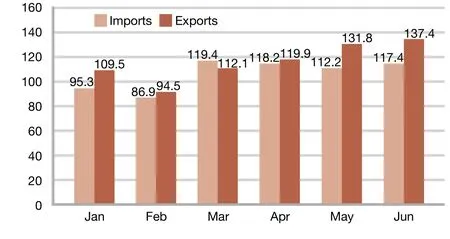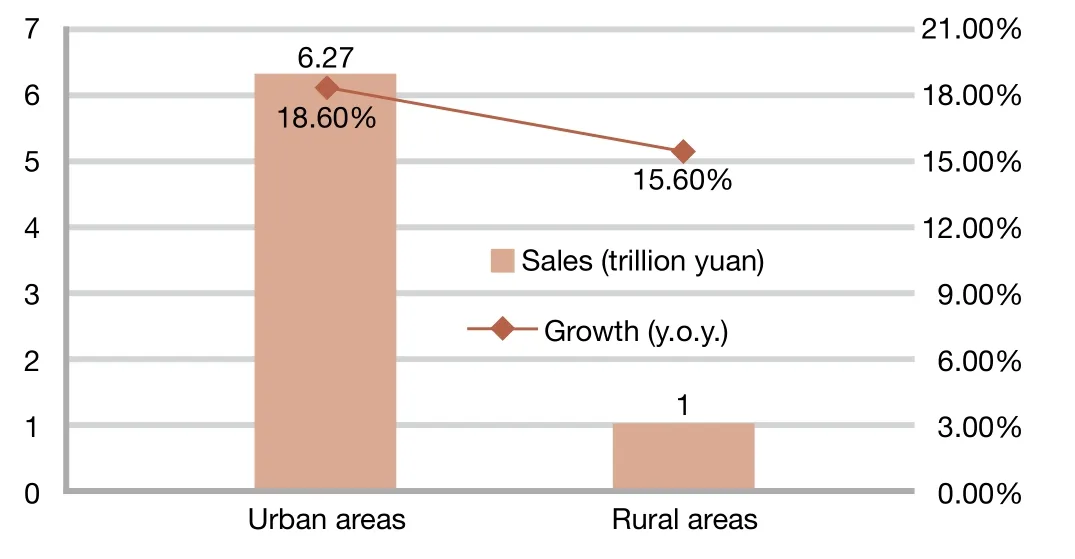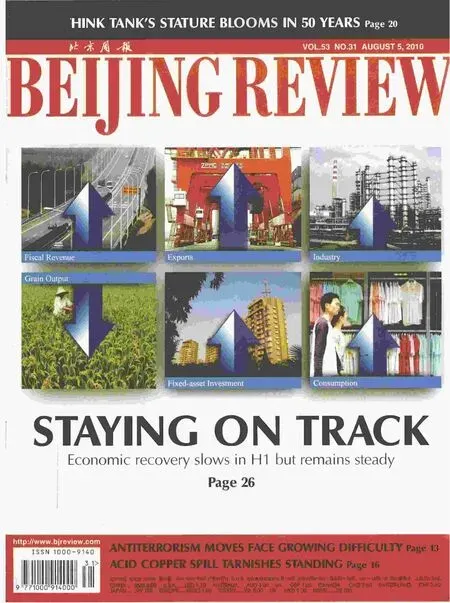SLOWER BUT HEALTHIER GROWTH
By LAN XINZHEN
SLOWER BUT HEALTHIER GROWTH
By LAN XINZHEN
China maintains high GDP growth, low unemployment rate and low inflation against the backdrop of a fragile global economic recovery
China’s economic growth has slowed,economic statistics released on July 15 show, confirming market expectations.But officials said the country’s economy is still on track.
The recovery has gained traction in China, which registered a double-digit growth of 11.1 percent in the fi rst half of this year.
“We will continue to implement the stimulus packages introduced after the fi nancial crisis, adjust the economic structure and transform the growth pattern, while the economy is on track to recovery,” Sheng Laiyun, spokesman for the National Bureau of Statistics (NBS),said at the July 15 press conference sponsored by the State Council Information Of fi ce.
Growth highlights
While maintaining a comparatively high growth rate, the Chinese economy has improved in growth quality in a coordinated way and re fl ected more fl exibility in economic policies, Sheng said.
“GDP grew 11.1 percent, up 3.7 percentage points year on year, and the country has reaped its third best summer grain harvest, despite the fact that drought has caused grain losses of 400 million kg,” he added.
Sheng said both domestic and overseas demand provided greater growth momentum for the Chinese economy in the fi rst six months of 2010, measured by investment,consumption and imports and exports.China’s fi xed asset investment growth in the first half slowed a bit to 25 percent, compared with 33.5 percent in the same period last year. Retail sales of consumer goods maintained a high growth rate at 18.2 percent. Total volume of exports and imports recovered quickly in the fi rst half, up 43.1 percent year-on-year, with imports posting a growth of 52.7 percent, said NBS statistics.
“Import increases are evidence of strong domestic demand, and economic growth represents a great contribution made by China to the global economic recovery,” he said.
In addition, the consumer price index, a barometer of inflation, rose 2.6 percent year-on-year, reflecting moderate and steady price increases of consumer goods, effectively easing both de fl ation and in fl ation sentiments.
由于农业生产活动对土地要素具有较强的依赖性,因此多位学者研究表明,应该在C-D生产函数中将耕地投入量引入为解释变量,并且将技术进步看成是时间的函数[3],新的生产函数为:
Employment also posted remarkable increases. While more than 5 million ur-ban residents found jobs in the fi rst half,about 6.32 million farmers joined the migrant workforce.
Both domestic and overseas demand provided greater growth momentum for the Chinese economy in the first six months of 2010,measured by investment,consumption and imports and exports
High quality also highlighted the economic growth. While fi scal revenues increased 27.6 percent, the pro fi t of stateowned and non-public enterprises with annual sales exceeding 5 million yuan($730,000) jumped 81.6 percent between January and May. The per-capita disposable income for urban residents rose 10.2 percent, while the real income for rural residents went up 12.6 percent.
Measures aimed to curb red-hot housing prices have also taken effect.Housing prices in 70 large and mediumsized cities slowed down in growth in June, down 1 percentage point from May. Measures taken to cut emissions and energy consumption have also kicked in. Both emissions and energy consumption have dropped signi fi cantly in energy-depleting industries since the second quarter.
Industrial performance
The industrial sector has continued the recovery trend, said Zhu Hongren, spokesman for the Ministry of Technology and Information Industry (MTII).
Industrial output grew steadily in the first half, while the gap between the growth of light and heavy industries narrowed month-by-month, and the growth of energy-depleting industries slowed down.
MTII statistics said the industrial valueadded of state-owned and non-public enterprises with annual sales exceeding 5 million yuan ($730,000) rose 17.6 percent year-on-year, 10.6 percentage points higher than the same period last year. The industrial value-added of light and heavy
industries went up by 13.6 percent and 19.4 percent, respectively, while the gap between the growth rates narrowed from 9.2 percentage points in January and February to 2.5 percentage points in June. Growth of steel, chemical and power industries dropped from 19.6 percent in the fi rst quarter to 17.2 percent in the second.

CPI & PPI Growth Rates (y.o.y.)

Imports and Exports ($bn)

Residents’ Income, H1 2010

GDP Growth Rates (y.o.y.)

Growth Rates of Fixed-asset Investment, H1 2010

Retail Sales of Consumer Goods, H1 2010

Growth Rates of House Prices in 70 Large and Medium-sized Cities (y.o.y.)
The decreases in energy-depleting industries helped improve the industrial structure, sharpen the competitiveness of China’s industrial sector and effectively cut emissions and energy consumption,therefore ensuring the sustainability of the economic growth, Zhu said.
Enterprises picked up in performance, too. Large state-owned and nonpublic enterprises in the industrial sector attained 1.54 trillion yuan ($226.5 billion) in pro fi ts, up 81.6 percent year on year for the January-May period, he said.The performance of small and mediumsized enterprises has improved too,thanks to supportive policies introduced last year by the Central Government.
Progress was also made in optimizing the structure of industrial investments and upgrading technologies in enterprises,he said. Fixed-asset investments in the industrial sector rose 22 percent in the fi st six months, down 6.7 percentage points year on year. Efforts to curb blind expansion in certain industries took effect, too.Investment growth in six energy-depleting industries declined from last year’s 25.6 percent to 16.3 percent. The 4,441 centrally subsidized projects of technological upgrading have all kicked off, with 662 of them beginning production.
Domestic demand
“China’s economic growth in the fi rst half was mainly driven by domestic demand,” said Wang Yiming, Vice President of the Academy of Macroeconomic Research under the National Development and Reform Commission.
NBS statistics said domestic demand contributed to 42 percent of China’s economic growth, while net exports, which used to see high reliance, contributed to 5.8 percent and 9.9 percent of GDP growth, respectively, in the second quarter and the fi rst quarter.
Domestic demand stimulated industrial growth, Zhu said. Domestic marketoriented industrial output jumped 34.9 percent year on year, accounting for 86.9 percent of the total output. It was 0.6 percentage point higher than the same period last year, and 3.4 and 5.2 percentage points higher, respectively, than in 2008 and 2007.
Measures to boost sales of home appliances and cars and to subsidize oldfor-new purchases have paid off, Zhu said. A total of 32.52 million sets of home appliances were sold in the first half of 2010, almost equal to that sold in all of 2009, and auto output and sales went up 48.8 percent and 47.7 percent,respectively, compared with the same period last year, he said.
Retail sales grew robustly in the fi rst half of 2010, driven by an increase in average income and continued consumption incentives, especially in lowend retailing, said a report compiled by CCB International (Holdings) Ltd., a wholly owned subsidiary of the China Construction Bank.
Domestic demand will continue to be the main growth momentum in the second half, the report said.
Difficulties
But difficulties remained for the Chinese economy in the fi rst six months of 2010, due to sovereign credit woes in Europe and problems with China’s economic growth pattern.
The economic growth slowed from 11.9 percent in the first quarter to 10.3 percent in the second, down 1.6 percentage points. This has raised concerns of another round of decline for China’s economic growth.
The decrease was largely because of the accelerating growth rates during the same period last year—in 2009, GDP growth jumped from 6.5 percent in the first quarter to 8.1 percent in the second quarter—as well as policies aimed to cool off excessive investments and speculations, Sheng said.
Despite the drop, the Chinese economy is still on track, because the second-quarter growth was basically consistent with the average rate between 2000 and 2009.
Sheng said China would maintain stability and continuity in macroeconomic policies, but increase flexibility,focus and predictability in accordance with complicated external conditions.
It was not necessary to worry about the slowdown of economic growth, and another round of decline is unlikely for the Chinese economy, he said.
And fl uctuating raw material prices and growing labor costs posed additional challenges to the Chinese economy,Zhu said. Labor costs in the Yangtze River and Pearl River deltas, China’s two manufacturing powerhouses, increased 20 to 25 percent in the fi rst half.
Also, small companies are facing increasing difficulties in securing loans.Export-oriented companies in processing industries, labor-intensive companies in particular, are sensitive to changes in macroeconomic policies and hesitate to ink both large and long-term contracts.

Newly Added Loan (billion yuan)

Foreign Direct Investment

